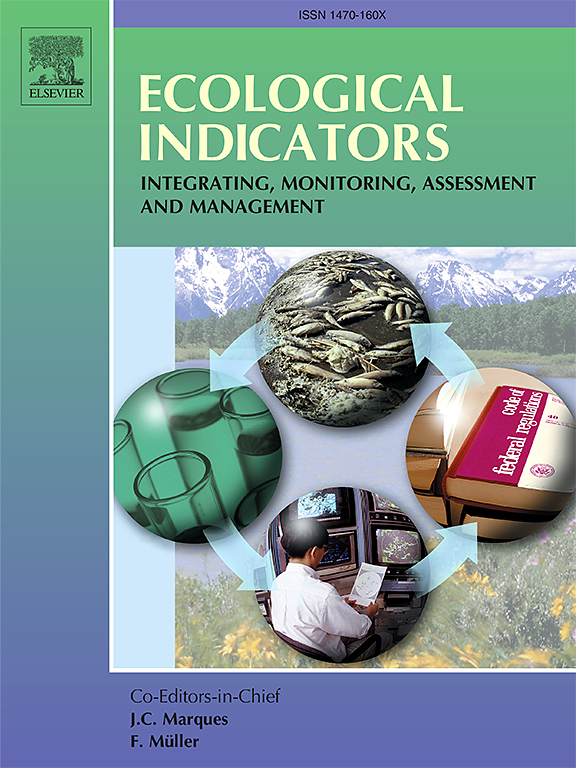基于系统动力学模型的柴达木盐湖资源环境承载力发展趋势分析与预警
IF 7
2区 环境科学与生态学
Q1 ENVIRONMENTAL SCIENCES
引用次数: 0
摘要
盐湖资源环境承载力评价是促进盐湖资源可持续开发利用的重要内容。采用系统动力学(SD)模型研究柴达木盐湖经济、水资源、矿产和环境之间的相互关系,科学地分析了盐湖钾锂资源开发的发展要求。建立了资源环境承载力综合评价体系。模拟4种不同发展情景,分析2021 - 2050年资源环境承载力的发展趋势,并进行预警。结果表明:①水资源与环境综合承载力呈现先下降后上升的趋势;水资源承载能力保持不超载,而环境承载能力出现超载迹象。(2)到2050年,预计钾肥的承载能力在791 ~ 917万吨之间,锂的承载能力在0.25 ~ 0.26万吨之间。(3)在业务照常(BAU)和需求增加情景(IDS)下,预计2027-2044年和2026-2050年期间分别出现橙色或红色预警。相比之下,资源节约方案(RSS)和技术提升方案(TES)的环境压力较低,只触发黄色警告。综合评估资源消耗、环境保护和经济发展后发现,工商业污水附加费方案最有利于区域可持续发展。研究结果为评价资源开发水平和减轻过度开发导致的资源枯竭和环境退化风险提供了科学依据。研究结果对柴达木盐湖的可持续管理策略有一定的参考价值。本文章由计算机程序翻译,如有差异,请以英文原文为准。
Development tendency analysis and early warning of resource and environmental carrying capacity based on system dynamics model in Qaidam salt Lake, China
Assessing the environmental carrying capacity for salt lake resources is essential for promoting sustainable development and use. A system dynamics (SD) model was employed to investigate the interrelationships among the economy, water resources, mineral resources, and the environment of Qaidam Salt Lake, scientifically focusing on the developmental requirements for potash and lithium resource development. An integrated evaluation system was developed to measure resource and environmental carrying capacity. Four different development scenarios were simulated to analyze the development tendencies of resource and environmental carrying capacity from 2021 to 2050, with early warnings issued. The results showed that: (1) The integrated carrying capacity of water resources and the environment initially declines before experiencing a subsequent increase. The water resources carrying capacity remains non-overloaded, while the environmental carrying capacity shows signs of overload. (2) By 2050, the carrying capacity for potash is projected to range from 7.91 to 9.17 million tons, whereas the carrying capacity for lithium is expected to range from 0.25 to 0.26 million tons. (3) Under the Business As Usual (BAU) and Increased Demand Scenarios (IDS), orange or red warnings are predicted during 2027–2044 and 2026–2050, respectively. In contrast, the Resource-saving Scenario (RSS) and Technology Enhancement Scenario (TES) result in lower environmental pressure, triggering only up to yellow warnings. A comprehensive assessment of resource consumption, environmental protection, and economic development shows that the TES scenario is most conducive to regional sustainable development. The findings provide a scientific basis for evaluating resource development levels and mitigating risks associated with resource depletion and environmental degradation due to over-exploitation. Furthermore, they contribute to sustainable management strategies for Qaidam Salt Lake and serve as a reference for similar regions.
求助全文
通过发布文献求助,成功后即可免费获取论文全文。
去求助
来源期刊

Ecological Indicators
环境科学-环境科学
CiteScore
11.80
自引率
8.70%
发文量
1163
审稿时长
78 days
期刊介绍:
The ultimate aim of Ecological Indicators is to integrate the monitoring and assessment of ecological and environmental indicators with management practices. The journal provides a forum for the discussion of the applied scientific development and review of traditional indicator approaches as well as for theoretical, modelling and quantitative applications such as index development. Research into the following areas will be published.
• All aspects of ecological and environmental indicators and indices.
• New indicators, and new approaches and methods for indicator development, testing and use.
• Development and modelling of indices, e.g. application of indicator suites across multiple scales and resources.
• Analysis and research of resource, system- and scale-specific indicators.
• Methods for integration of social and other valuation metrics for the production of scientifically rigorous and politically-relevant assessments using indicator-based monitoring and assessment programs.
• How research indicators can be transformed into direct application for management purposes.
• Broader assessment objectives and methods, e.g. biodiversity, biological integrity, and sustainability, through the use of indicators.
• Resource-specific indicators such as landscape, agroecosystems, forests, wetlands, etc.
 求助内容:
求助内容: 应助结果提醒方式:
应助结果提醒方式:


